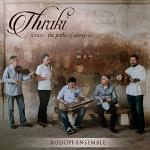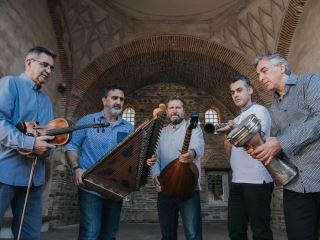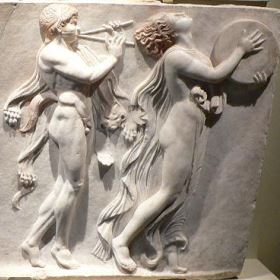FolkWorld #68 03/2019
Music of Thrace
Thraki is a terrific collection of traditional Thracian songs and dances from the veteran Rodopi Ensemble.
Music of Thrace is the music of Thrace, a region in Southeastern Europe spread over southern Bulgaria (Northern Thrace), northeastern Greece (Western Thrace), and European Turkey (Eastern Thrace).
The music of Thrace contains a written history that extends back to the antiquity, when Orpheus became a legendary musician and lived close to Olympus. Though the Thracian people were eventually assimilated by surrounding Balkan groups, elements of Thracian folk music continue.

Track Listing
1. Synkathistos (Synkathistos dance)
2. Tsakitzis (name of a folk hero)
3. Apo tin Prousa kinisa (Starting from Bursa)
4. Baidouska (Baidouska dance)
5. Kita me glikia mou agapi (Look at Me, Sweet Love)
6. Mia Paraskevi (On a Friday)
7. Tora pou stisan ton choro (Now that they Started Dancing)
8. Roman Havasi (The Air of Gypsies)
9. Margoudi (Mantilatos dance)
10. Balos and Sousta (Balos and Sousta dances)
11. Menexédes kai zouboulia (Violets and Hyacinths)
Rodopi Ensemble "Thraki - Thrace – The Paths of Dionysus", ARC Music, 2019

Drosos Koutsokostas (vocals, lute)
Kyriakos Petras (violin)
Nikos Angousis (clarinet)
Alkis Zopoglou (kanun)
Yorgos Pagozidis (percussion)
Traditional Thracian dances are usually swift in tempo and are mostly circle dances in which the men dance at the front of the line. The gaida, a kind of bagpipe, is the most characteristic instrument, but clarinets and toumbelekis are also used. The Thracian gaida, also called the avlos, is different from the Macedonian or other Bulgarian bagpipes. It is more high in pitch then the Macedonian gaida but less so than the Bulgarian gaida (or Dura). The Thracian gaida is also still widely used throughout Thrace in northeastern Greece.
Types of dances
- Chelebinsko (Chain Dance of the Gentlemen): is a choreography by Belco Stanev with great music in an interesting meter. It's 9/8 divided : 2 3 2 2. In the vocal part, the steps are exactly on the meter: QSQQ, but in the instrumental refrain, half a bar is added 2 3 (QS). The steps are in 2 2 2 3 (QQQS) and the missing half bar 2 2 (QQ) is added at the end so that is missing (mathematically).
- Izgryala E Mesechinka (The moon has risen): A beautiful song from Northern (Bulgarian) Thrace that has inspired many choreographies, all of them with extensive arm work that is typical in dances from this region.
- Jambolsko Paidushko: Pajdusko/Paidushko horo/Baiduska, etc. is a family of dances usually danced to 5/16 or 5/8 (Q S) rhythm and found in a large area spanning Serbia, Macedonia, Bulgaria, Greece, and beyond. It is the classic "aksak" (Turkish for limping) dance and rhythm. Its various forms reflect local preferences. This one is from the Jambol region in Northern (Bulgarian) Thrace, and was first introduced in the States by Dick Crum.
- Krivo Sadovsko Horo (Twisted chain dance from Sadovo, Northern Thrace): Very fast dance, with special rhythm (13/8), this dance has many versions.
- Pazardzhishka Kopanitsa: Pazardzhik Kopanitsa from Pazardzhik, Northern Thrace.
- Pravo Trakiisko Horo: Pravo Trakiisko Horo (Straight Thracian chain dance) is from Northern Thrace. It has very little in common with the simple Pravo horo(straight chain dance). It's a challenging choreography by a performing group that was brought down from the stage.
- Sedi Donka (Donka is sitting): One of the most unusual musical patterns in Bulgaria, Sedi Donka is in 25/16 meters. It is subdivided 7+7+11, which in turn can be subdivided 3 2 2, 3 2 2, 2 2 3 2 2.
- Trakiiska Rachenitsa: Trakiiska Rachenitsa is a highly stylized rachenitsa from Northern Thrace with lots of arm work.
- Trite Pati: Trite Pati (the three times) is a dance from Northern Thrace. Like some other Thracian dances, it is also danced in Western (Greek) Thrace.
- Kuluriastos: Kuluriastos is a Greek dance from Western Thrace. It has a slower Zonaradikos part, and a faster part where the beginning of the line loops into the center and back out again. It's a lot of fun to dance this, especially if the dancer is near the beginning of the line. As with many Greek dances, it can be danced to many songs. This one is Pses idia st'oniro mu.
- Sfarlis: Sfarlis is a beginner's dance from Western Thrace.
- Troiro: Many Bulgarian dances from Northern Thrace have "cousins" (very similar dances) in Western (Greek) Thrace, and this is one of them: a Greek dance that sounds and feels Bulgarian.
- Dostlar Bizim Halaya: This is a rom dance from Eastern (Turkish) Thrace. It is a reminmder of the so-called "tsigansko horo" (gypsy chain dance), but the dances are not at all alike.
- Hassapia: an ancient dance that simulates a stealth approach on any enemy camp, from beginning to victory. The hassapia dance has been dated back to Hellenistic times, before the time of Alexander the Great whose soldiers brought it to Macedonia. It is a warrior's dance in which the movements represent the noiseless approach on the enemy camp, the encounter, the fight, and the victory. This dance is done in a circle using a shoulder hold. A similar dance called "kasapsko horo" (butcher's chain dance) is performed in Bulgaria.
- Kallinitikos: performed by three people (either two men and one woman or two women and one man), named after the kalines, or friends of the bride during her wedding, who escort her to the church performing this dance. Kallinitikos is a dance done by groups of three people: a man in the middle and two women at his sides or a woman in the middle and two men at her sides. The dance is named after the kalines, the bride's girlfriends, who do this dance as they escort her to the church. Performed in Western Thrace.
- Kouseftos: derived from kousevo (to run in the Ancient Thracian language), performed, not in a circle, but in the form of a labyrinthKouseftos, with its characteristic quick running steps, takes its name from the word kousevo in Ancient Thrace which means 'to run. It differs from other Thracian dances in that, instead of being danced in a circle, its dance progression takes the form of a labyrinth. Performed in Western Thrace.
- Mandilatos (Mandra): a couples dance performed at weddings. Mandilatos is a couples' dance which takes its name from the mandilia or handkerchiefs that the dancers hold while dancing. This dance is done at weddings as the guests escort the bride or the best man to the church. During the procession, some guests hold a mirror which symbolizes the purity of the bride and others hold brooms which symbolize her housekeeping ability. This dance is performed in Western Thrace. A similar dance called "rachenitsa" (from "raka" - an arm) is performed in Northern Thrace.
- Stis tris: a slow but swift dance. Stis Tris means "in threes." Each dance set is composed of three parts of four steps each. The arms are held down and move in a synchronized motion with the steps. This dance is performed under different names in Northern Thrace and Western Thrace.
- Syngathistos: performed as the bride and groom are escorted to and from the church during weddings. Syngathistos is a free style couples dance that is danced as the bride and groom are escorted to and from the church. The bridal party also dances as they display and exchange gifts with the bride and groom, particularly gifts of handkerchiefs and head scarves. This dance is performed in Western Thrace.
- Xesyrtos: a circle dance with men performed at the front of the line. Xesyrtos is a circle dance in which the men dance at the front of the line, followed by the women, and do variations to the dance step with characteristic slaps, jumps, and kicks. This dance is performed in Western Thrace.
- Zonaradikos: a circle dance in which the participants hold each other's belts. This is the primary dance of Western Thrace and primarily danced by men where many tricks are performed. The Zonaradikos is a circle dance in which the dancers hold each other by their belts or zonaria (hence the name Zonaradikos). This dance is done in every village and region of Thrace. Three variations of the basic step are paties or stomps, monopatia or single stomp, and psalidia or scissors, usually followed by the koulouriastos or curling. A similar dance called "na poyas" (for belt) is found in Northern Thrace.
- Dousko Zonaradiko-Tsestos: Tsestos is a challenging dance from Northern Greece(the region named Thrace or in Greek language Thraki). The dance starts with a moderate rhythm and is danced by both men and women with very few figure(this is an intro dance named Dousko, the steps are the same as the dance Zonaradiko (twelve steps) . As it goes on men come in front and they catch each other by the zonari (belt). At this point the dance becomes very quick and it consists of figures only(on twelve steps too). It performed by the Greek population of Northern Thrace (Anatoliki Romylia) and continues to be performed by all Greeks. It has roots in the most ancient dance of the world, the Greek dance Pyrihios which also has twelve steps. Bulgarian Trakiisko Pravo Horo has a lot in common with dousko zonaradiko Tsestos because in the past Greek population live on this field of Northern Thrace at Byzantine ages and now Bulgarians and many Greeks live in this area.
- Paidushko (Baiduska, Pajdusko, Pajduska, Payduska): a very aggressive dance, usually performed by men. It is performed using heavy movement. Performed in all three regions of Thrace: Northern (Paidushko Horo), Western (Baiduska), and Eastern (Payduska).
- Halay: Halay is a famous dance in the Middle East. It is a symbol for the tempestuous way of life in its place of origin, Anatolia. It is a national dance in Armenia and Turkey. The traditional form of the Halay dance is played on the Zurna, supported by a Davul. The dancers form a circle or line while holding each other with the little finger. From Anatolia the Halay has spread to many other regions such as Armenia and the Balkans.
- Karsilama: a dance found in both Western and Eastern Thrace.

From Wikipedia, the free encyclopedia
[en.wikipedia.org/wiki/Music_of_Thrace].
Wikipedia® is a registered trademark of the Wikimedia Foundation, Inc., a non-profit organization.
Text is available under the Creative Commons Attribution-ShareAlike License.
Date: February 2019.
Photo Credits:
(1) Dionysus,
(2)-(3) Rodopi Ensemble
(unknown/website).
FolkWorld - Home of European Music
 Layout & Idea of FolkWorld © The Mollis - Editors of FolkWorld
Layout & Idea of FolkWorld © The Mollis - Editors of FolkWorld



